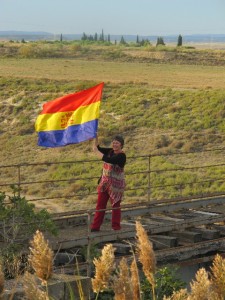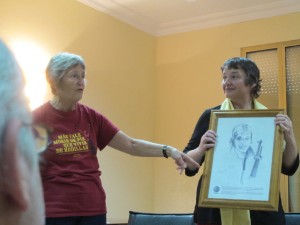The IBMT Tour of the Aragon Front: Browne, Cornford & Heinemann
Last October I joined the IBMT tour headed by Pauline Fraser and Charles Jepson, which took us along the trenches of Quito, the battle sites of Belchite, and included a visit to the new Battle of the Ebro Museum at Fayon. In the spirit of the Brigades, we were truly an international group, comprised of family members and supporters of the International Brigades from Puerto Rico, the United States, the Netherlands, Ireland, Australia and our hosts from Great Britain. Because of our make up, we not only learned about the Spanish Anti-Fascist War from our local guides at the battle sites, but also had some of the most meaningful exchanges over meals within our own group, hearing, for example, of the harsh post war experiences of the Brigadistas from countries which had fallen to the fascists. The superlative job of translation done by Almudena Cros from AABI, gave us access to the accounts of local historians such as Victor Pardo and Antonio Jardiel, and even time for informal Q and A’s.
While we have been fortunate this year to have had the opportunity to see the art of VALB Ralph Fasanella at the American Folk Art Museum in NYC, and to enjoy the work by VALB Anthony Toney installed at the Tamiment Library which houses our archives, this tour introduced me to the work and inspiring life of the artist Felicia Browne, the only British woman combatant and the first British Volunteer to fall in Spain. Some of the rare work she produced during that period was presented to the mayor of Tardiente, the closest town to where she had fallen, by her great niece Glenda Browne and tour leader Pauline Fraser. Her work was scarce during that period because of a conscious sacrifice she made as an artist, grappling with the demands of her art and her response to what she termed “the earthquake which is happening in the revolution.
Another highlight of the tour was the opportunity to hear the words of John Cornford and his fiancée Margot Heinneman, recited by Margot’s daughter Jane Bernal at the site where Cornford wrote “Letter from Aragon.”
Of special interest to the family members and friends of the Lincolns, which included Nancy Phillips and Margarita Lopez and myself, was the lecture by Catalan historian Anna Marti on The Great Retreats. Her masterful exposition of the strategy and deployment of the Lincolns, based on an analysis of research from the first hand accounts of the Volunteers, was followed by a visit to the sites related to the Great Retreats of the Lincolns. It was a highlight not only for the Americans, but for the other participants as well. We’re all eager to hear more of her work.
It was a privilege to be a part of this effort to keep alive the anti fascist ideals of the International Brigades through the transcendent art and poetry of Felicia Browne and John Cornford, who sacrificed their lives in Spain.
Nancy Wallach is an ALBA Board Member and daughter of VALB Hy Wallach
















I am not a member of AlLBA, but I am a personal friend of Nancy Wallach. After having read her article in “The Volunteer”, I find myself very interested in learning more about the Abraham Lincoln Brigade and the work of ALBA in preserving the legacy of these very brave volunteers in their fight against Fascism!
I am nota member of ALBA, but I am a personal friend of Nancy Wallach. After having read her article in the “Volunteer”, I find myself very interested in learning more about the Abraham Lincoln Brigade and the work of ALBA in preserving the legacy of these brave Volunteers in their fight against fascism.